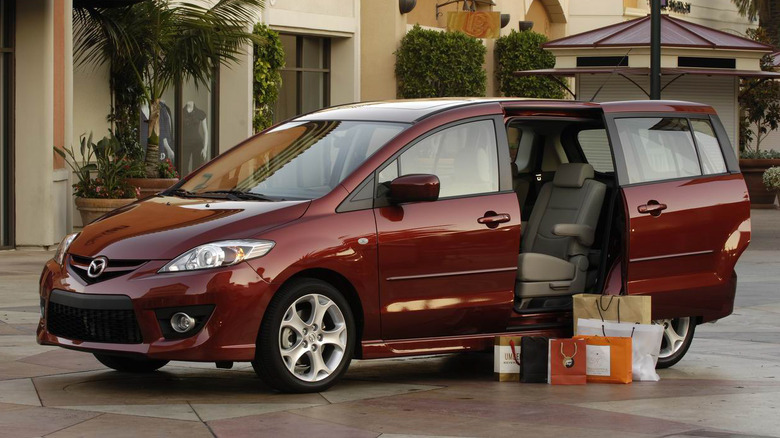Why Mazda Discontinued The MPV & Which Minivan Model Replaced It
Mazda discontinued the MPV minivan after the 2006 model year. The Mazda MPV had gone through two generations, the first running from the 1992 through 1998 model years, and the second spanning the 2000 to 2006 model years — there was no 1999 MPV model. What was really driving the demise of the Mazda MPV was also what caused reduced sales of minivans across the board: The rise of consumer preference for SUVs.
The increasing choice of SUVs for not only families of five, but also those with seven members, had driven the massive market growth of these vehicles. Three-row SUVs had overtaken minivans as the form factor of choice for large families. Another thing that led vehicle manufacturers to follow this body style change were the much larger sticker prices that could be achieved by selling SUVs over minivans. Mazda was following this trend when they dropped the MPV and introduced the seven-passenger CX-9 SUV to replace it, joining its five-passenger CX-7 on the showroom floor.
Fast forward to today, and you can see the consequences of this trend in Mazda's current 2025 model lineup. With the exception of the two Mazda MX-5 Miata variants and the two Mazda3 variants, every other Mazda, if you include hybrids and plug-in hybrids, are SUVs. This is a total of eight separate models out of 12, meaning that SUVs represent two thirds of Mazda's products.
Which minivan model replaced the Mazda MPV?
The minivan model that replaced the Mazda MPV was the Mazda5, a minivan that had a smaller footprint than the MPV and could seat a maximum of six people in its U.S. market configuration, and it was sold here from the 2005 through the 2015 model years. The Mazda5 never sold as well as the MPV had during its days in the U.S. market. This is likely because it was noticeably smaller than the MPV, due to it being based on a compact car platform. While some buyers preferred its smaller, more nimble size, most minivan buyers were after the biggest box-on-wheels they could get. The Mazda5 did not fall under that category and its poor sales reflected this, even though it had one of the most reliable Mazda engines ever built.
The Mazda5 also suffered from the same trend that ended the Mazda MPV's stay on our shores. This was the rise of SUVs as the dominant vehicle choice in the U.S. market. Within the Mazda lineup in 2014, the Mazda5 sold 11,613 units, compared to the CX-5 SUV's much larger 99,112 sales during the same period. This has continued to the present day, which helps to explain why there are only four minivans on the market, the Honda Odyssey, the Toyota Sienna, the Kia Carnival, and the Chrysler Pacifica/Voyager, totaling 323,390 units in 2024. The vastly higher number of SUVs accounts for a total of 9.17 million units purchased out of 15.9 million vehicles sold in 2024, which comes out to 57.7% market share for SUVs last year.

